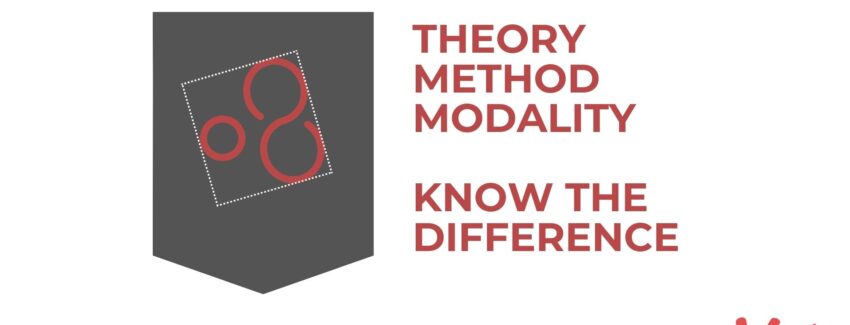Theory, Method, Modality, and Technique Definitions
Sidenote: You could also call these Theory, Therapy, conText, and Technique if you wanted the alliteration.
Definitions of Theory, Method, Modality, and Techniques
A precise understanding of the distinctions between theory, method, and modality is paramount in the realm of therapeutic intervention. Although these terms may be used interchangeably at times, they represent unique constructs that contribute to the overall effectiveness of therapeutic approaches.
Theory acts as a comprehensive framework, aiding therapists in comprehending why patients may encounter specific difficulties and guiding them on the best approach to address these challenges. By organizing concepts and ideas into a cohesive construct, theory facilitates therapists' understanding of how a person's thoughts and beliefs can impact their mental health and determines the most appropriate techniques to tackle these concerns. For instance, cognitive learning theory can illuminate how an individual's thoughts and beliefs contribute to mental health issues, subsequently suggesting suitable interventions.
Method refers to a specific therapeutic intervention that is influenced by theory. It is the practical application of theory to achieve the desired outcomes or changes. Methods encompass various techniques, including cognitive-behavioral therapy, talk therapy, or expressive arts therapy. These methods aim to facilitate change by equipping individuals with coping strategies, skills, and insights specific to their needs.
Modality pertains to the environmental context in which the therapeutic intervention takes place. Social workers, for example, learn about "person in environment" and various systems, represented by the acronym IFGOC, which stands for Individuals, Families, Groups, Organizations, and Communities. The modality recognizes that the surrounding environment plays a crucial role in an individual's mental health and treatment.
Techniques are coping strategies taught as part of a therapeutic intervention. These approaches empower patients to manage symptoms and cope with challenges. Techniques may include mindfulness meditation, journaling, deep breathing exercises, and more. Technique is closely linked to method, as the specific coping strategies taught align with the theoretical framework and method employed.
Case Study:
Sarah is a graduate student in social work and is researching various therapeutic approaches to anxiety disorders. She is especially interested in exploring the relationship between theory, method, modality, and techniques in therapeutic interventions.
After conducting her research, Sarah decides to focus on cognitive-behavioral therapy (CBT) as her therapeutic approach. CBT is a popular method that is based on the theoretical framework of cognitive learning theory. The cognitive learning theory suggests that a person's thoughts and beliefs influence their emotions and behaviors. Sarah recognizes that by addressing and modifying these beliefs and thoughts, she can assist individuals in overcoming their anxiety symptoms.
For her research, Sarah selects a specific modality, which refers to the environmental context of the intervention. She chooses the modality of "person in environment" as she believes that a person's environment plays an essential role in their mental health. Sarah delves deeper into the client's social, cultural, and economic environment to ensure the most effective treatment for anxiety disorders.
Sarah also recognizes the importance of teaching coping strategies to clients. She chooses to employ relaxation techniques, including deep breathing exercises and progressive muscle relaxation, as coping strategies. These techniques align with the CBT method and can be helpful to clients in managing their symptoms.
In conclusion, effective therapeutic interventions require an understanding of the distinctions between theory, method, modality, and techniques. Sarah's research on CBT with a modality of "person in environment" and relaxation techniques as techniques can provide insight into tailoring interventions to the individual needs of people struggling with anxiety disorders.
Understanding the Differences Between Theory, Method, Modality, and Technique: Why it Matters for Students in Clinical Practice
- Conceptual clarity: Recognizing the distinctions between theory, method, modality, and technique provides students with a clear and organized understanding of therapeutic interventions. This clarity allows students to accurately interpret and apply the knowledge they acquire during their studies.
- Effective treatment selection: Knowledge of theory, method, modality, and technique empowers students to make informed decisions when selecting therapeutic approaches. Understanding the theories underlying different methods helps students evaluate their suitability for specific client populations and clinical presentations. Additionally, familiarity with various modalities enables students to identify appropriate coping strategies to enhance treatment effectiveness. The integration of techniques allows students to determine the specific interventions and strategies to address the client's needs.
- Individualized treatment planning: Grasping the differences between theory, method, modality, and technique enables students to develop individualized treatment plans that align with their clients' unique needs. They can select methods, modalities, and techniques that best match the theoretical framework that underlies their approach to therapy. This personalized approach increases the likelihood of positive therapeutic outcomes by tailoring techniques to address the specific goals and challenges of each client.
- Evidence-based practice: Proficiency in theory, method, modality, and technique allows students to stay updated with the latest research findings and evidence-based practices. This awareness ensures that students choose interventions that have been supported by empirical evidence, promoting more effective therapeutic interventions. By incorporating evidence-based techniques into their treatment plans, students can enhance the overall effectiveness and quality of care provided to their clients.
In summary, theory, method, modality, and technique are all crucial components of therapeutic interventions. Understanding the distinctions between these constructs is essential for students to provide effective and evidence-based care. By integrating theory, method, modality, and technique into a cohesive treatment plan, therapists can help patients achieve positive outcomes and make progress towards their mental health goals. This knowledge enhances students' ability to conceptualize treatments, select appropriate methods, identify suitable coping strategies, and implement evidence-based techniques. By applying this understanding, students can provide effective, individualized, and evidence-based care to their clients, leading to positive therapeutic outcomes.

